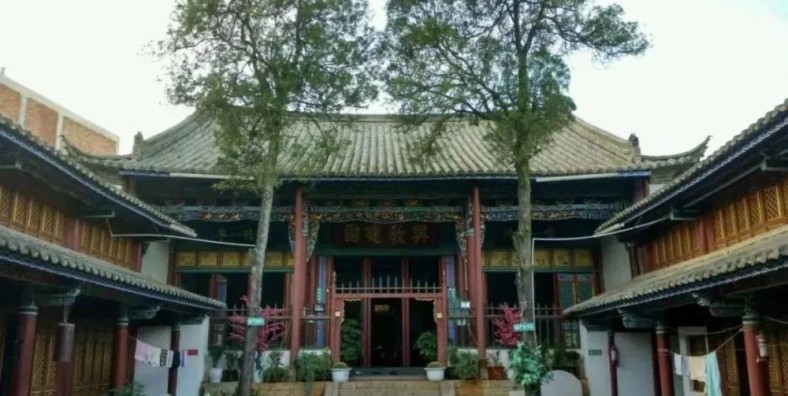
Tangzi Mosque in Xundian County, Kunming

Chinese Name: 塘子清真寺
Chinese Pinyin: Kunming Tangzi Qing Zhen Si
English Name: Tangzi Mos
Type: Mosque, Cultural & Historical Landmarks
Visiting Hours: 30 minutes - 1 hour
Opening Time: 8:00-17:30
Tickets Fee: Free
Address: Tangzi Village, Tangzi Town, Xundian County, Yunnan Province
Tangzi Mosque (塘子清真寺) is a local mosque with a long history located in Tangzi Village (塘子大村), Tangzi Town (塘子街道), Xundian County (寻甸县), Yunnan Province (云南省). It was originally built in the early Ming Dynasty and serves as a typical example of the Sinicization of Islam, which is fully reflected in its strong traditional Chinese architectural style. The overall layout of the mosque features a combination of individual buildings forming courtyards, and these courtyards are arranged in a structure of two successive courtyards. The complex comprises more than 40 rooms, including the main prayer hall, ablution rooms, scripture hall, and other auxiliary facilities.
Historical Background
Tangzi Mosque (塘子清真寺), also known as Tangzi Qingzhen Temple (塘子清真寺), was initially constructed during the mid-Ming Dynasty and was later rebuilt during the reign of Emperor Qianlong of the Qing Dynasty. The mosque complex includes an Islamic study hall, a minaret, a main prayer hall, auxiliary rooms, and a kitchen, totaling more than 50 rooms.
Historical Events
In the 9th year of the Republic of China (1920), Tangzi Village (塘子大村) suffered from bandit raids, resulting in the destruction of the mosque by fire. In response, the villagers raised reconstruction funds by selling over 10 acres of temple land. The reconstruction began in 1923 (Republic of China Year 12) and was completed in 1927 (Republic of China Year 16). In 1937 (Republic of China Year 26), a grand stone-arch entrance gate was added. The mosque’s facade features five minarets atop a three-story base, reflecting fine craftsmanship and architectural grandeur. The eaves of the main prayer hall are decorated with intricate floral and bird carvings, showcasing high artistic value.
Artistic Significance
Three notable plaques are mounted above the main hall:
- “Promoting Education and Nation Building” (兴教建国), presented by Bai Chongxi (白崇禧), Minister of Military Training of the Republic of China in 1944 (Republic of China Year 33).
- “Unique and Excellent” (独具一格), presented by Lieutenant General Ma Yong (马雍) in 1941 (Republic of China Year 30).
- “Myriad Uniqueness” (万象独奇), presented by Major General Ma Boliang (马伯良) in 1941 (Republic of China Year 30).
During the Republic of China period, the mosque also served as the venue for meetings of the Islamic Progress Association and the Islamic Salvation Association branch. It was also the site of the Awen Girls’ School (阿文女子学校).
Post-1958 Developments
After 1958, religious activities at the mosque were suspended and the premises were repurposed. In 1982, the Xundian County Government allocated funds for its restoration, reinstating it as a religious site for the local Muslim community in Tangzi Village (塘子大村).
Muslim Travel Tips
Visiting Hours
Please check designated visiting hours in advance, as the mosque now primarily functions as a religious venue.
Respectful Visits
Visitors are expected to behave respectfully and follow any dress codes or guidelines provided by the mosque.

 7 Days GolfingTour
7 Days GolfingTour
 8 Days Group Tour
8 Days Group Tour
 8 Days Yunnan Tour
8 Days Yunnan Tour
 7 Days Shangri La Hiking
7 Days Shangri La Hiking
 11 Days Yunnan Tour
11 Days Yunnan Tour
 6 Days Yuanyang Terraces
6 Days Yuanyang Terraces
 11 Days Yunnan Tour
11 Days Yunnan Tour
 8 Days South Yunnan
8 Days South Yunnan
 7 Days Tea Tour
7 Days Tea Tour
 8 Days Muslim Tour
8 Days Muslim Tour
 12 Days Self-Driving
12 Days Self-Driving
 4 Days Haba Climbing
4 Days Haba Climbing
 Tiger Leaping Gorge
Tiger Leaping Gorge
 Stone Forest
Stone Forest
 Yunnan-Tibet
Yunnan-Tibet
 Hani Rice Terraces
Hani Rice Terraces
 Kunming
Kunming
 Lijiang
Lijiang
 Shangri-la
Shangri-la
 Dali
Dali
 XishuangBanna
XishuangBanna
 Honghe
Honghe
 Kunming
Kunming
 Lijiang
Lijiang
 Shangri-la
Shangri-la
 Yuanyang Rice Terraces
Yuanyang Rice Terraces
 Nujiang
Nujiang
 XishuangBanna
XishuangBanna
 Spring City Golf
Spring City Golf
 Snow Mountain Golf
Snow Mountain Golf
 Stone Mountain Golf
Stone Mountain Golf


















